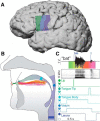Differential Representation of Articulatory Gestures and Phonemes in Precentral and Inferior Frontal Gyri
- PMID: 30257858
- PMCID: PMC6234299
- DOI: 10.1523/JNEUROSCI.1206-18.2018
Differential Representation of Articulatory Gestures and Phonemes in Precentral and Inferior Frontal Gyri
Abstract
Speech is a critical form of human communication and is central to our daily lives. Yet, despite decades of study, an understanding of the fundamental neural control of speech production remains incomplete. Current theories model speech production as a hierarchy from sentences and phrases down to words, syllables, speech sounds (phonemes), and the actions of vocal tract articulators used to produce speech sounds (articulatory gestures). Here, we investigate the cortical representation of articulatory gestures and phonemes in ventral precentral and inferior frontal gyri in men and women. Our results indicate that ventral precentral cortex represents gestures to a greater extent than phonemes, while inferior frontal cortex represents both gestures and phonemes. These findings suggest that speech production shares a common cortical representation with that of other types of movement, such as arm and hand movements. This has important implications both for our understanding of speech production and for the design of brain-machine interfaces to restore communication to people who cannot speak.SIGNIFICANCE STATEMENT Despite being studied for decades, the production of speech by the brain is not fully understood. In particular, the most elemental parts of speech, speech sounds (phonemes) and the movements of vocal tract articulators used to produce these sounds (articulatory gestures), have both been hypothesized to be encoded in motor cortex. Using direct cortical recordings, we found evidence that primary motor and premotor cortices represent gestures to a greater extent than phonemes. Inferior frontal cortex (part of Broca's area) appears to represent both gestures and phonemes. These findings suggest that speech production shares a similar cortical organizational structure with the movement of other body parts.
Keywords: articulatory gestures; brain–computer interface; encoding; phonemes; segments; speech production.
Copyright © 2018 the authors 0270-6474/18/389803-11$15.00/0.
Figures





References
-
- Bakovic E. (2014) Phonology and phonological theory. In: The Oxford handbook of language production (Goldrick MA, Ferreira V, Miozzo M, eds), pp 199–209. Oxford: Oxford UP.
-
- Ballard KJ, Granier JP, Robin DA (2000) Understanding the nature of apraxia of speech: theory, analysis, and treatment. Aphasiology 14:969–995. 10.1080/02687030050156575 - DOI
Publication types
MeSH terms
Grants and funding
LinkOut - more resources
Full Text Sources
Other Literature Sources
